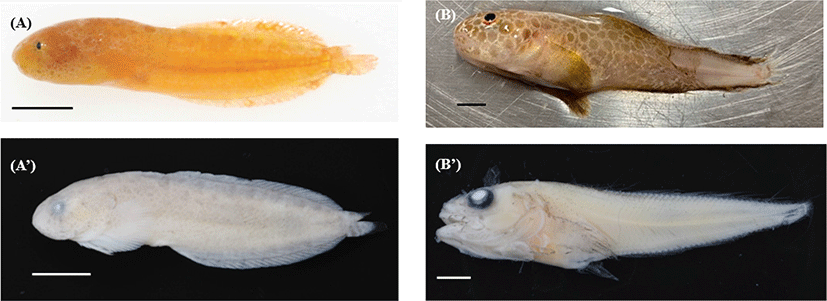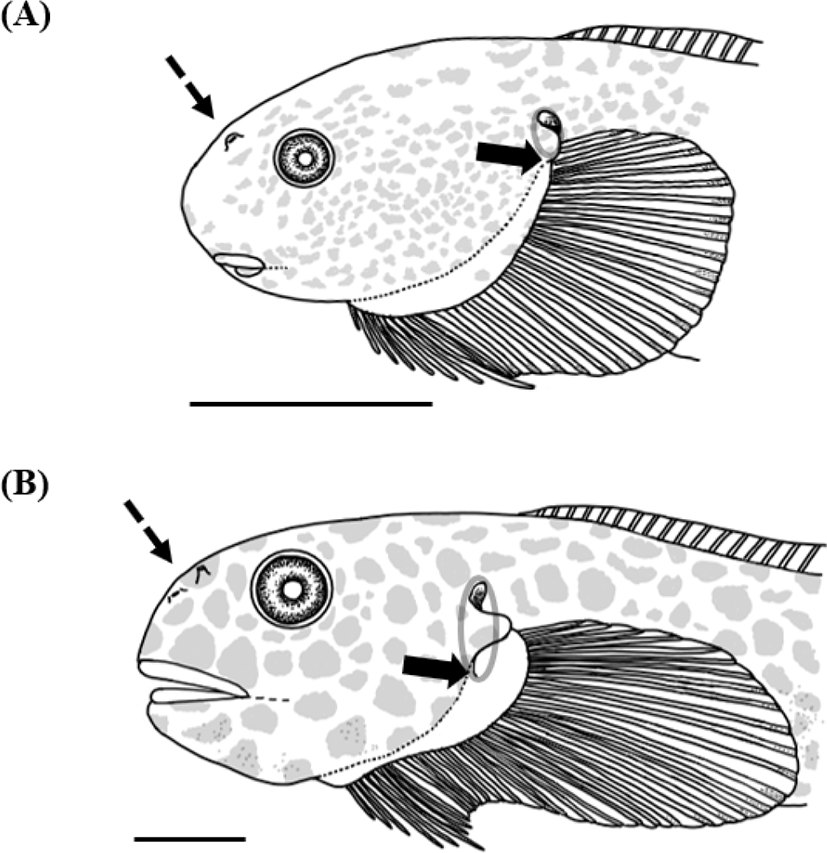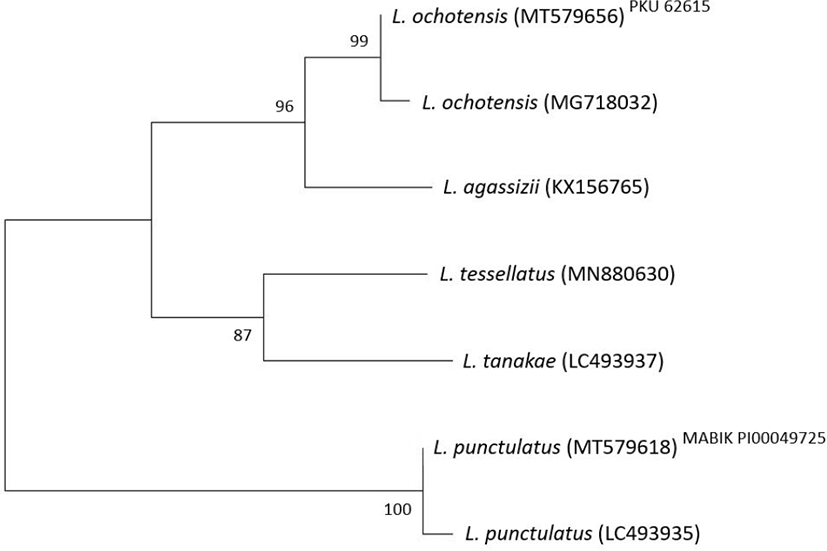Introduction
The Liparidae comprise 56 genera and 493 species, which inhabit shallow water to the deep sea worldwide (Eschmeyer et al., 2020). Six species in genus Liparis have been reported in Korea: Liparis agassizii, Liparis chefuensis, Liparis megacephalus, Liparis ochotensis, Liparis tanakae, and Liparis tessellatus (Ji et al., 2012; MABIK, 2019; Park et al., 2013; Song et al., 2015). The liparid species occur mostly in temperate regions of the North Pacific and Antarctic Oceans but are also found in the Arctic and North Atlantic Oceans (Knudsen et al., 2007). Traits used to identify and classify Liparidae include the number of nostrils, position of the anus, and fin ray counts (Sokolovskii & Sokolovskaya, 2003).
In August 2016, a Liparidae individual was collected in Gijang, Busan, southeastern Korea. At first, it was morphological identified as juvenile stage of L. tanakae or L. ochotensis, but when was observed in detail, the size of the gill opening of it was different from them. Morphological identification suggested that it was Liparis punctulatus, which was confirmed by comparing the mtDNA 16S rRNA nucleotide sequence. In this study, we report the detailed morphological and molecular characteristics based on a L. punctulatus voucher specimen for the first reliable record in Korea.
Materials and Methods
On 4 August, 2016, a Liparidae individual was collected in about 1 m depth using with a beach seine, in Gijang, Busan, Korea (35°22’4794”N, 129°22’8325”E). The specimen was fixed in 15% formalin after collection and then washed and preserved in 99% EtOH. It was registered and deposited in the Ichthyology Laboratory collection of Pukyong National University (PKU).
The terms and names of each body part and the three counts used (dorsal, anal, and pectoral fin rays) follow the method of Nakabo & Kai (2013). The 14 measurements were obtained according to Kido (1988). The morphological characters were observed using a stereo microscope (SZH-16, Olympus, Japan) and measured to 0.1 mm using a microscope photography device (Active Measure, Fuzhou, China) and Vernier calipers.
Genomic DNA was extracted from the lateral body using Chelex 100 resin (Bio-Rad, Hercules, CA, USA). The extracted genomic DNA was preserved at 5°C in a refrigerator until used for polymerase chain reaction (PCR). The primers 16Sar-5°C and 16Sbr-3’ (Palumbi, 1996) were used to amplify the mitochondrial DNA (mtDNA) 16S rRNA gene. PCR was performed by adding 3 μL genomic DNA to a mixture of 3 μL 10× PCR buffer, 2.4 μL 2.5 mM dNTP, 1 μL forward and reverse primers, 0.2 μL Takara Taq polymerase, and 20.4 μL distilled water to give a final volume of 30 μL. Then, PCR was performed using a thermal cycler (MJ mini PCT-1148, Bio-Rad, Hercules, California, USA) with an initial denaturation at 95°C for 11 min; 35 cycles of 94°C for 1 min, 58°C for 1 min, and 72°C for 1 min; a final extension at 72°C for 5 min; and an infinite hold at 4°C. The PCR products were sequenced on the ABI PRISM 3730XL Analyzer (96 capillary type) using BigDye® Terminator v3.1 cycle sequencing kits (Applied Biosystems, Foster City, CA, USA). Genetic distances were calculated by the Kimura (1980) 2-parameter model using the program MEGA X (Kumar et al., 2018), and the genetic relationships were analyzed by constructing a neighbor-joining tree using MEGA X (Kumar et al., 2018) with 1,000 bootstrap replications. The sequences of seven Liparidae species obtained from NCBI GenBank were compared: L. punctulatus (LC493935), Liparis agassizii (KX156765), Liparis tessellatus (MN880630), Liparis tanakae (LC493937), Liparis ochotensis (MG718032). The 16S rRNA sequences of the specimen and L. ochotensis determined in this study were registered at NCBI GenBank (nos. MT579618 and MT579656).
Results
Careproctus punctulatusTanaka, 1916: 174 (type locality: Bishamon, Misaki, Kanagawa, Japan).


Liparis punctulatus: Kido, 1988: 168 (Japan); Chernova et al., 2008: 840 (East China Sea and Japan); Nakabo & Kai, 2013: 1206 (Japan); Parin et al., 2014: 340 (Japan); Myoung et al., 2015: 101 (Korea); Kim et al., 2019: 248 (Korea).
MABIK PI00049725 (Previously: PKU 62613), one individual, 30.9 mm SL, coastal water off Gijang, Busan (35°22’4794”N, 129°22’8325”E), August 4, 2016, by beach seine, about 1 meter depth, collector Se Hun Myoung.
A pair of nostrils; very small gill opening; the pectoral fin origin at the bottom of the gill opening.
Counts and measurements are shown in Table 1.
| Characters | Liparis punctulatus | Liparis ochotensis | Liparis tanakae | Liparis tessellatus | ||
|---|---|---|---|---|---|---|
| Present study | Tanaka (1916) | Kido (1988) | Present study | Kido (1988) | Kido (1988) | |
| Registration number | MABIK PI00049725 | PKU 62615 | ||||
| Number of specimens | 1 | 1 | ||||
| Standard length (mm) | 30.9 | - | 21.0–83.0 | 59.4 | 99.0–474.0 | 79.0–211.0 |
| Counts | ||||||
| Dorsal fin rays | 32 | - | 31–33 | 44 | 42–44 | 45–48 |
| Anal fin rays | 26 | - | 25–28 | 37 | 34–35 | 37–40 |
| Pectoral fin rays | 33 | - | 29–33 | 40 | 39–45 | 35–40 |
| As % of standard length | ||||||
| Head length | 30.1 | 26.1 | 24.9–30.2 | 30.1 | 23.8–29.8 | 21.7–26.6 |
| Body depth | 23.0 | 26.7 | 20.4–30.1 | 19.7 | 21.6–27.8 | 16.8–26.5 |
| Head width | 19.1 | - | 19.4–26.1 | 14.8 | 18.0–25.4 | 14.2–17.7 |
| Predorsal fin length | 28.8 | - | 25.7–34.6 | 36 | 24.5–33.5 | 25.1–31.9 |
| As % of head length | ||||||
| Snout length | 35.5 | 36.4 | 33.2–39.4 | 27.9 | 38.3–47.5 | 33.5–41.1 |
| Eye diameter | 12.9 | - | 12.9–18.0 | 17.9 | 9.7–15.5 | 14.6–25.6 |
| Interorbital width | 38.7 | - | 36.9–44.1 | 17.9 | 43.4–54.1 | 44.5–52.5 |
| Upper jaw length | 40.9 | - | 34.8–46.6 | 46.9 | 43.6–57.3 | 35.5–45.9 |
| Lower jaw length | 45.2 | - | 32.6–45.9 | 40.8 | 38.5–50.4 | 45.9–60.8 |
| Snout-to-disk length | 50.5 | - | 47.6–71.0 | 61.5 | 40.8–62.0 | 53.1–68.0 |
| Snout-to-anus length | 118.3 | - | 116.3–136.1 | 133.5 | 120.3–135.8 | 130.2–174.2 |
| Disk-to-anus length | 12.9 | - | 12.3–42.8 | 40.8 | 31.9–55.2 | 39.1–85.7 |
| Anus-to-anal fin length | 35.5 | - | 32.3–68.5 | 30.2 | 14.6–30.0 | 14.4–35.4 |
The body shape long oval and flat with a narrow width; the body depth almost constant and decreases at the caudal fin. The head size normal, but eye and mouth small; the nostrils a pair, slightly protruding in short tubular form. The mouth on the ventral of the head; the lower jaw smaller than the upper jaw, and the lower lip is almost inside the upper lip. The gill opening very small. The pectoral fin origin at the bottom of the gill opening and extends to the side of the pelvic fin disk; the pectoral fin oval with a long serrated bottom. The pelvic fin round and large in the form of a large suction disk. The anus located in the middle of the protruding end of the gill opening. The dorsal fin slightly longer than the anal fin, and both extend to the caudal fin. The caudal fin rounded. No scales on the body surface, but small protuberances cover the head and body (Figs. 1A and 2A).
When the specimen was fresh, body yellowish overall with small brown dots over the entire body; no dots on the pectoral fin; horizontal lines of the same color as the dots on the caudal fin; scattered dot pattern on the head.
After the specimen was preserved, body light yellow to white; the head and bases of dorsal and anal fins dark brown.
The sequence of 514 base pairs of the mtDNA 16S rRNA gene (positions 1008–1521) was determined. Comparing the sequence with those of Liparidae registered in NCBI GenBank, the genetic distance was closest to L. punctulatus (LC493935; d = 0.002) and distant from other Liparidae, including L. ochotensis (PKU 62615; d = 0.060), L. ochotensis (MG718032; d = 0.062), L. agassizii (KX156765; d = 0.064), L. tanakae (LC493937; d = 0.064), L. tessellatus (MN880630; d = 0.065) (Fig. 3).

Western North Pacific; Coastal water off Busan (present study), Japan (Chernova, 2008; Nakabo & Kai, 2013; Parin et al., 2014), and China (Chernova, 2008).
Remarks
A Liparidae individual collected in the waters near Gijang, Busan, Korea on August 4, 2016 was identified as L. punctulatus based on morphological and molecular analyses. L. punctulatus is difficult to identify because of its similar body shape and color to those of L. ochotensis. Table 1 shows comparisons of the counts and measurements of the two species. L. punctulatus has small gill opening, and the lower end of gill opening overlaps the second ray of pectoral fin, whereas L. ochotensis has large gill opening that reaches the 18th ray of pectoral fin. In addition, L. punctulatus has one pair of nostrils, whereas L. ochotensis has two pairs (Figs. 1 and 2).
L. tanakae and L. tessellatus, which are frequently caught in the waters near Busan, are distinct from L. punctulatus. Unlike L. punctulatus, L. tanakae and L. tessellatus have large gill openings that reach the 5th to 12th and 15th to 23rd rays, respectively. Both also have two pairs of nostrils. L. tanakae and L. tessellatus are distinguished from L. punctulatus in that L. tanakae has dark spots or vertical stripes on its bright body, and L. tessellatus has white dots on its dark brown body and more than four-fifths its dorsal fin is fused to its caudal fin. L. chefuensis is similar to L. punctulatus because of the yellowish body but is morphologically distinct from L. punctulatus in terms of the presence of two pairs of nostrils and dark brown vertical stripes on the body. The morphological differences are also evident in the counts and measurements shown in Table 1 (Kido, 1988; Nakabo & Kai, 2013; Song et al., 2015).
Kido (1988) classificated L. ingens as the synonym with L. punctulatus. Then, L. ingens that meaned L. ochotensis in Chyung (1961) also recorded as the synonym with L. punctulatus in Kido (1988). Based on this, Youn (2002) recorded L. ingens as L. punctulatus, and Nakabo & Kai (2013) in Japan reported that L. punctulatus lived in Korea.
Park et al. (2018) reported the relations about weight and length for L. punctulatus in Korea. The individuals that Park et al. (2018) evaluated were collected at depths of 50–100 m and measured up to 70 cm TL (total length), whereas L. punctulatus was recorded as a small fish, with a maximum SL of approximately 8 cm, in shallow water at 0–20 m depths (Nakabo & Kai, 2013; Myoung et al., 2015). Therefore, it seems incorrect identification of L. tanakae or L. ochotensis. In this study, L. punctulatus and a young L. ochotensis were similar to external morphological characters but had obvious morphological and molecular differences.
No study has evaluated the morphological and molecular characteristics of L. punctulatus in Korea based on a voucher specimen. Compared with Kido (1988), Nakabo & Kai (2013), Tanaka (1916), and, the L. punctulatus individual observed in this study was similar to L. punctulatus in terms of morphological characteristics, including the fin ray counts and measurements, and the mtDNA 16S rRNA sequence of L. punctulatus registered in NCBI GenBank. Therefore, we gave L. punctulatus, which we first identified by morphological and molecular analyses in this study, the Korean name “Kko-ma-kkom-chi” proposed by Myoung et al. (2015) and Kim et al. (2019).








